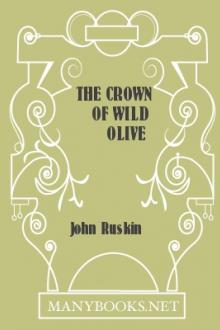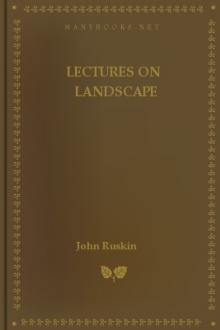The Crown of Wild Olive by John Ruskin (a court of thorns and roses ebook free .TXT) 📕

- Author: John Ruskin
- Performer: -
Book online «The Crown of Wild Olive by John Ruskin (a court of thorns and roses ebook free .TXT) 📕». Author John Ruskin
148. Of course, any kind of work in glass, or in metal, on a large scale, involves some painful endurance of heat; and working in clay, some habitual endurance of cold; but the point beyond which the effort must not be carried is marked by loss of power of manipulation. As long as the eyes and fingers have complete command of the material (as a glass blower has, for instance, in doing fine ornamental work)—the law is not violated; but all our great engine and furnace work, in gun-making and the like, is degrading to the intellect; and no nation can long persist in it without losing many of its human faculties. Nay, even the use of machinery, other than the common rope and pully, for the lifting of weights, is degrading to architecture; the invention of expedients for the raising of enormous stones has always been a characteristic of partly savage or corrupted races. A block of marble not larger than a cart with a couple of oxen could carry, and a cross-beam, with a couple of pulleys, raise, is as large as should generally be used in any building. The employment of large masses is sure to lead to vulgar exhibitions of geometrical arrangement,[127] and to draw away the attention from the sculpture. In general, rocks naturally break into such pieces as the human beings that have to build with them can easily lift, and no larger should be sought for.
149. In this respect, and in many other subtle ways, the law that the work is to be with tools of men is connected with the farther condition of its modesty, that it is to be wrought in substance provided by Nature, and to have a faithful respect to all the essential qualities of such substance.
And here I must ask your attention to the idea, and, more than idea,—the fact, involved in that infinitely misused term, "Providentia," when applied to the Divine Power. In its truest sense and scholarly use, it is a human virtue, Προμηθεια; the personal type of it is in Prometheus, and all the first power of τεχνη, is from him, as compared to the weakness of days when men without foresight "εφυρον εικη παντα." But, so far as we use the word "Providence" as an attribute of the Maker and Giver of all things, it does not mean that in a shipwreck He takes care of the passengers who are to be saved and takes none of those who are to be drowned; but it does mean that every race of creatures is born into the world under circumstances of approximate adaptation to its necessities; and, beyond all others, the ingenious and observant race of man is surrounded with elements naturally good for his food, pleasant to his sight, and suitable for the subjects of his ingenuity;—the stone, metal, and clay of the earth he walks upon lending themselves at once to his hand, for all manner of workmanship.
150. Thus, his truest respect for the law of the entire creation is shown by his making the most of what he can get most easily; and there is no virtue of art, nor application of common sense, more sacredly necessary than this respect to the beauty of natural substance, and the ease of local use; neither are there any other precepts of construction so vital as these—that you show all the strength of your material, tempt none of its weaknesses, and do with it only what can be simply and permanently done.
151. Thus, all good building will be with rocks, or pebbles, or burnt clay, but with no artificial compound; all good painting, with common oils and pigments on common canvas, paper, plaster, or wood,—admitting, sometimes for precious work, precious things, but all applied in a simple and visible way. The highest imitative art should not, indeed, at first sight, call attention to the means of it; but even that, at length, should do so distinctly, and provoke the observer to take pleasure in seeing how completely the workman is master of the particular material he has used, and how beautiful and desirable a substance it was, for work of that kind. In oil painting its unctious quality is to be delighted in; in fresco, its chalky quality; in glass, its transparency; in wood, its grain; in marble, its softness; in porphyry, its hardness; in iron, its toughness. In a flint country, one should feel the delightfulness of having flints to pick up, and fasten together into rugged walls. In a marble country one should be always more and more astonished at the exquisite colour and structure of marble; in a slate country one should feel as if every rock cleft itself only for the sake of being built with conveniently.
152. Now, for sculpture, there are, briefly, two materials—Clay, and Stone; for glass is only a clay that gets clear and brittle as it cools, and metal a clay that gets opaque and tough as it cools. Indeed, the true use of gold in this world is only as a very pretty and very ductile clay, which you can spread as flat as you like, spin as fine as you like, and which will neither crack, nor tarnish.
All the arts of sculpture in clay may be summed up under the word "Plastic," and all of those in stone, under the word "Glyptic."
153. Sculpture in clay will accordingly include all cast brick-work, pottery, and tile-work[128]—a somewhat important branch of human skill. Next to the potter's work, you have all the arts in porcelain, glass, enamel, and metal; everything, that is to say, playful and familiar in design, much of what is most felicitously inventive, and, in bronze or gold, most precious and permanent.
154. Sculpture in stone, whether granite, gem, or marble, while we accurately use the general term "glyptic" for it, may be thought of with, perhaps, the most clear force under the English word "engraving." For, from the mere angular incision which the Greek consecrated in the triglyphs of his greatest order of architecture, grow forth all the arts of bas-relief, and methods of localized groups of sculpture connected with each other and with architecture: as, in another direction, the arts of engraving and wood-cutting themselves.
155. Over all this vast field of human skill the laws which I have enunciated to you rule with inevitable authority, embracing the greatest, and consenting to the humblest, exertion; strong to repress the ambition of nations, if fantastic and vain, but gentle to approve the efforts of children, made in accordance with the visible intention of the Maker of all flesh, and the Giver of all Intelligence. These laws, therefore, I now repeat, and beg of you to observe them as irrefragable.
1. That the work is to be with tools of men.
2. That it is to be in natural materials.
3. That it is to exhibit the virtues of those materials, and aim at no quality inconsistent with them.
4. That its temper is to be quiet and gentle, in harmony with common needs, and in consent to common intelligence.
We will now observe the bearing of these laws on the elementary conditions of the art at present under discussion.
156. There is, first, work in baked clay, which contracts as it dries, and is very easily frangible. Then you must put no work into it requiring niceness in dimension, nor any so elaborate that it would be a great loss if it were broken, but as the clay yields at once to the hand, and the sculptor can do anything with it he likes, it is a material for him to sketch with and play with,—to record his fancies in, before they escape him—and to express roughly, for people who can enjoy such sketches, what he has not time to complete in marble. The clay, being ductile, lends itself to all softness of line; being easily frangible, it would be ridiculous to give it sharp edges, so that a blunt and massive rendering of graceful gesture will be its natural function; but as it can be pinched, or pulled, or thrust in a moment into projection which it would take hours of chiselling to get in stone, it will also properly be used for all fantastic and grotesque form, not involving sharp edges. Therefore, what is true of chalk and charcoal, for painters, is equally true of clay, for sculptors; they are all most precious materials for true masters, but tempt the false ones into fatal license; and to judge rightly of terra-cotta work is a far higher reach of skill in sculpture-criticism than to distinguish the merits of a finished statue.
157. We have, secondly, work in bronze, iron, gold, and other metals; in which the laws of structure are still more definite.
All kinds of twisted and wreathen work on every scale become delightful when wrought in ductile or tenacious metal, but metal which is to be hammered into form separates itself into two great divisions—solid, and flat.
Incised Outline and Opened Space.
(A.) In solid metal work, i. e., metal cast thick enough to resist bending, whether it be hollow or not, violent and various projection may be admitted, which would be offensive in marble; but no sharp edges, because it is difficult to produce them with the hammer. But since the permanence of the material justifies exquisiteness of workmanship, whatever delicate ornamentation can be wrought with rounded surfaces may be advisedly introduced; and since the colour of bronze or any other metal is not so pleasantly representative of flesh as that of marble, a wise sculptor will depend less on flesh contour, and more on picturesque accessories, which, though they would be vulgar if attempted in stone, are rightly entertaining in bronze or silver. Verrochio's statue of Colleone at Venice, Cellini's Perseus at Florence, and Ghiberti's gates at Florence, are models of bronze treatment.
(B.) When metal is beaten thin, it becomes what is technically called "plate," (the flattened thing) and may be treated advisably in two ways; one, by beating it out into bosses, the other by cutting it into strips and ramifications. The vast schools of goldsmith's work and of iron decoration, founded on these two principles, have had the most powerful influences over general taste in all ages and countries. One of the simplest and most interesting elementary examples of the treatment of flat metal by cutting is the common branched iron bar, Fig. 8, used to close small apertures in countries possessing any good primitive style of iron-work, formed by alternate cuts on its sides, and the bending down of the several portions. The ordinary domestic window balcony of Verona is formed by mere ribands of iron, bent into curves as studiously refined as those of a Greek vase, and decorated merely by their own terminations in spiral volutes.
All cast work





Comments (0)